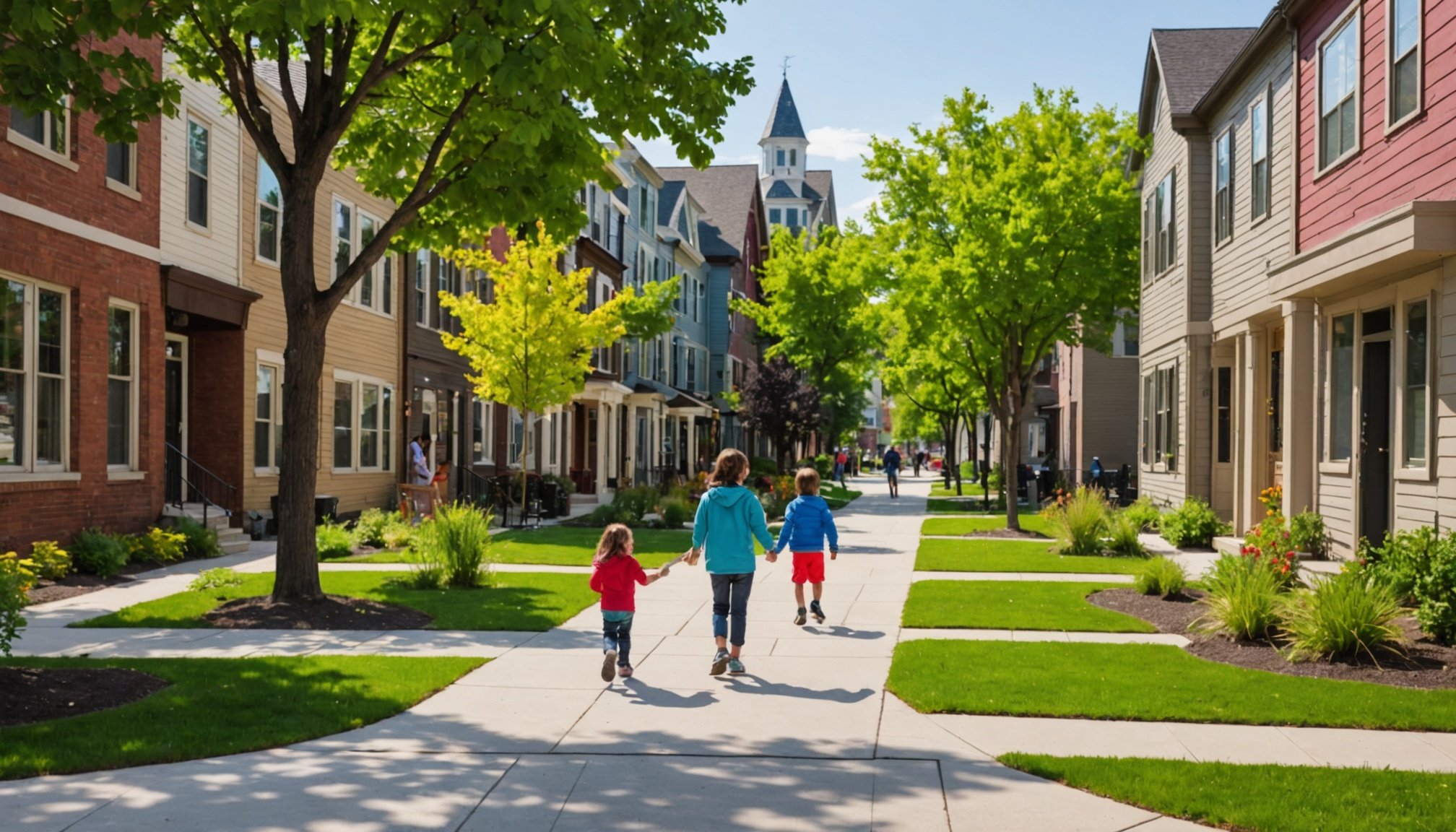Importance of Family-Centric Urban Design
Incorporating family-friendly neighborhoods in urban planning is vital for fostering community safety and well-being. Prioritizing families creates environments conducive to children’s development and enhances the overall quality of life.
Providing safe environments in urban areas allows children to explore and grow without undue risks. This safety is fundamental for their emotional and social development, as it encourages independent play and discovery. Designing spaces with children in mind, such as parks and recreational facilities, provides ample opportunities for learning and healthy interactions.
Also read : Creating Safe and Engaging Play Spaces for Children in Urban Apartment Communities
Furthermore, community cohesion plays a significant role in family well-being. When neighborhoods are designed to be more family-centric, they promote stronger interpersonal connections among residents. These ties contribute to a supportive network, offering a sense of belonging and shared responsibility. Elements like pedestrian-friendly streets, community centers, and accessible public transport not only improve safety but also strengthen these social bonds.
By integrating family priorities into urban design, cities can create vibrant, nurturing landscapes that support the needs of all residents. This approach not only benefits families but also contributes to a more inclusive, connected community.
Have you seen this : Creating Inclusive Public Spaces: A Guide to Accessible Design in Mixed-Use Developments
Key Elements of Child-Friendly Neighborhoods
Creating environments where children can thrive involves well-thought-out urban planning and child-friendly design features. Let’s explore these essential components.
Safe Play Areas
Designing safe play areas is vital for fostering child development and ensuring their well-being. These areas should be accessible and designed to stimulate physical activities, creativity, and social interaction. Safety elements such as soft ground surfaces, enclosed play structures, and appropriate signage further enhance a child’s play experience by reducing accident risks and providing peace of mind for parents.
Accessible Parks and Green Spaces
Accessible parks and inclusive green spaces foster not just physical health but also mental wellness. These areas offer children the liberty to explore nature, sparking curiosity and learning. Urban planners focus on creating parks with diverse natural elements, making them equally engaging for children and adults. Well-maintained paths, seating, and play facilities are essential to enhance park usability for families.
Traffic Calming Measures
Implementing traffic calming measures is fundamental to child-friendly neighborhoods. By reducing vehicle speeds through design features like speed bumps, narrowed roads, and pedestrian zones, neighborhoods become safer for kids. These measures lead to a more enjoyable, stress-free environment for everyone, encouraging outdoor activities and community engagement.
Community Engagement in Urban Planning
Engaging the local community, including families and stakeholders, in urban planning is crucial for creating sustainable and vibrant environments. A participatory design approach ensures that diverse voices are heard, and community involvement becomes a cornerstone of effective planning.
Involving Families in the Planning Process
In urban planning, involving families as stakeholders provides valuable insights into community needs. Incorporating family perspectives requires proactive strategies, such as inviting their participation in design discussions and integrating family-friendly amenities into plans. This ensures the environment reflects the needs and values of those living there.
Hosting Community Workshops
Community workshops play a vital role in stakeholder engagement, fostering a shared vision for urban spaces. These workshops allow participants to collaborate, discuss ideas, and influence planning decisions. Effective workshops focus on inclusivity and open dialogue, ensuring that every voice is heard and respected.
Gathering Feedback through Surveys
Surveys are a practical tool for capturing diverse community needs and opinions. Utilizing surveys allows planners to collect broad-spectrum data from a large population, making it easier to identify trends and inform planning decisions. By strategically distributing surveys, communities can channel feedback into actionable insights that guide development.
Case Studies of Successful Family-Friendly Neighborhoods
Examining case studies of successful urban design yields invaluable insights into crafting family-friendly neighborhoods. These examples demonstrate how thoughtful planning can create supportive environments for families.
Examples from Around the Globe
Globally, several neighborhoods are celebrated for their innovative, family-friendly urban design. Vauban in Freiburg, Germany is renowned for its car-free zones and sustainable architecture. Meanwhile, Hammarby Sjöstad in Stockholm, Sweden, showcases effective integration of eco-friendly features with family-oriented spaces. These neighborhoods offer inspiring examples of how effective urban design can foster a family-centric community.
Lessons Learned from Innovative Designs
Key lessons from these urban design examples include prioritising pedestrian pathways and creating easily accessible green spaces. Planners embraced mixed-use developments, accommodating both residential and communal facilities, which promote social interaction. Engaging community input during planning also emerged as a crucial factor in these case studies.
Analysis of Community Impact
The impact of these neighborhoods on families highlights the significant benefits of strategic urban planning. Successful neighborhoods foster a sense of community, enhancing social ties and contributing to parents’ and children’s well-being. Access to public transportation and local schools enhances the community’s appeal. These results affirm the potential of thoughtful design to transform urban landscapes into havens for families.
Expert Insights on Designing Inclusive Spaces
Designing inclusive spaces requires an understanding of diverse needs, particularly through the lens of urban design experts and child development specialists. This multidisciplinary approach ensures that urban environments accommodate all segments of the population, especially families and children.
Interviews with Urban Planners
Urban planners emphasize the necessity of incorporating inclusive planning practices that cater to various demographics. Key considerations include accessible public transportation, safe pedestrian pathways, and multi-use public spaces. Planners advocate for environments where families feel welcome and children can explore safely.
Insights from Child Development Specialists
Child development specialists provide crucial insights into how urban design impacts youngsters’ growth. They stress the importance of creating spaces that foster physical activity, social interaction, and creativity. Features like open playgrounds, nature trails, and interactive installations can greatly benefit child development.
Recommendations for Future Urban Policies
Experts recommend several approaches, such as:
- Gathering expert opinions to create practical, family-friendly environments.
- Focusing on the intersection of design and child development to enrich children’s experiences.
- Advocating for policies that prioritize building more inclusive, vibrant urban spaces.
By synthesizing these insights, urban design can evolve to support a more holistic and inclusive community framework.
Practical Tips for Implementing Family-Centric Design
When considering family-centric design, it’s essential to incorporate practical tips in your urban design implementation. Starting with an assessment of your neighborhood is crucial to understand current conditions.
Assessing Your Neighborhood
Begin by evaluating your neighborhood for family-friendliness. Analyze factors such as safety, accessibility, and amenities tailored for children and caregivers. This evaluation will help pinpoint areas needing adjustments. Are playgrounds accessible? Are sidewalks wide enough for strollers? These considerations ensure a supportive environment for families.
Collaborating with Local Governments
Engaging local governments is a vital step in urban design implementation. Establishing partnerships with city planners can provide resources and support for your initiatives. Discuss potential family-centric design options with them. Inviting government officials to community meetings helps align public policies with family needs. A supportive government can assist in funding and executing proposed changes.
Encouraging Local Families to Participate
Family involvement is key to successful urban design implementation. Encourage local families to actively participate in planning sessions. Their real-life experiences offer valuable insights into what truly benefits the community. Organize workshops or surveys to gather feedback, ensuring that your neighborhood developments reflect the residents’ genuine requirements. By including families in decision-making processes, you foster a sense of community ownership and relevance.











